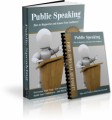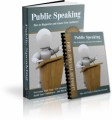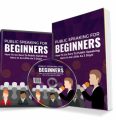Ebook Sample Content Preview
Day 1
Speaking in front of people, large crowds in particular, is usually perceived as the most stressful experience imaginable. The following ideas in this course are designed to help you, or anyone for that matter, convey your ideas and messages to either one person, or a large group in just about any setting. Creating an effective presentation, can seem very overwhelming. But here are strategies you can use to come up with an effective and powerful speech in 30 minutes or less, regardless of your target audience.
#1 Identifying your purpose
The importance of goal-setting must not be overlooked when preparing for any presentation. The very first thing you need do before you even embark on your presentation is to define your objectives. It is crucial that you begin with the end in mind. Ask yourself this, “What do I want to achieve from my speech?”, “What do I want my audience to receive?”, “What do I want my audience to do next?”
The first thing you need to do in the speech preparation process is to identify your purpose. The purpose of your presentation can range from creating awareness, fostering understanding, generating impact, selling a product, or even to inspire your audience. Remember that the main reason why you’re presenting in the first place is to give, not just gain. As such, your goals should be aligned with allowing your audience to benefit from your presentation. Your purpose-setting must be extremely clear, not just to yourself, but to your audience as well. This helps them internally craft the benefits they will gain from listening to you.
The biggest mistake of public speaking is when you start with the wrong purpose in mind. Mediocre speakers operate without a specific purpose which can easily cause stress and anxiety. The nature of your purpose is just as important as the purpose itself. Many speakers often mistakenly assume or even subconsciously decide that their purpose is audience validation and approval. Wrong. This is completely foolish. This causes great pressure on the speaker to be absolutely perfect in order to win unanimous approval and this causes a great deal of anxiety. I call this a “stress-producing” purpose.
Once you’ve established the purpose of your presentation, you can easily craft your presentation around it in order for it to be achieved. Remember that the essence of public speaking is not to GAIN something, but to GIVE something. When you operate with that frame of mind, you automatically tune your body language, tone of voice and craft content that is useful for your audience. With that, you immediately attract the attention of the majority.
To conclude this section, here’s a quick summary. Before even writing your speech, you need to clearly define your objectives and ask yourself, “What do you want to achieve with this?” and to set goals that benefit not just yourself, but your audience as well. Now that you’ve identified the purpose of your speech, you can move on to the next stage.
Other Details* File Format: MS Word Doc, PDF
* Number of Pages: 31
* Included Graphics: Ecovers, PSD
* Download File Size: 3,244 KB














